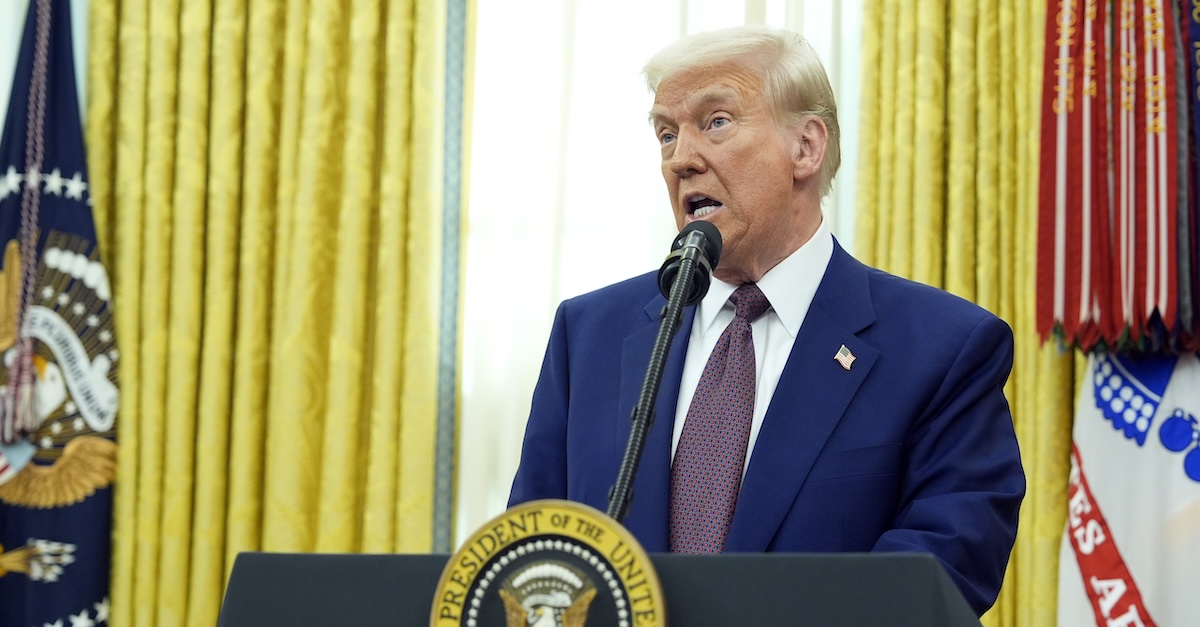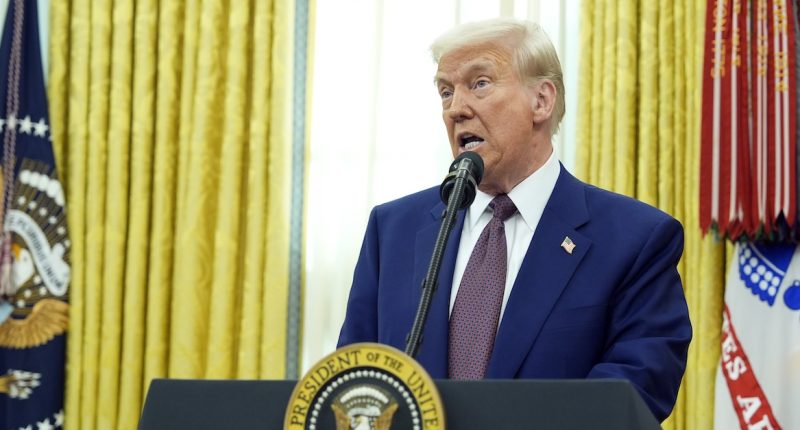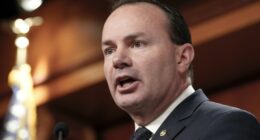
President Donald Trump speaks before Robert F. Kennedy Jr., is sworn in as HHS Secretary in the Oval Office, Thursday, Feb. 13, 2025, in Washington (Photo/Alex Brandon).
A federal judge on Thursday extended a pause on the spending freeze instituted during the nascent days of the Trump administration.
On Jan. 31, U.S. District Judge John McConnell issued a temporary restraining order blocking the controversial and often murky directive — making good on his earlier voiced inclinations from the bench in which the judge suggested he would put the kibosh on the policy.
Since then, the government has been accused of violating the restraining order twice, with the judge finding those allegations credible in each case. The government then twice tried to have the restraining order stayed by the First Circuit Court of Appeals and failed each time.
Now, in a 45-page memorandum order, myriad executive agencies are “enjoined from reissuing, adopting, implementing, giving effect to, or reinstating under a different name the directives” emanating from the infamous Office of Management and Budget (OMB) memo mandating a federal governmentwide “temporary pause” on spending.
In the order, the court found the Trump administration likely violated several tenets of the Administrative Procedure Act (APA), other federal laws that mandate the distribution of congressionally-appropriated funds, and key aspects of the U.S. Constitution.
“The Executive’s categorical freeze of appropriated and obligated funds fundamentally undermines the distinct constitutional roles of each branch of our government,” the order begins. “The interaction of the three co-equal branches of government is an intricate, delicate, and sophisticated balance — but it is crucial to our form of constitutional governance. Here, the Executive put itself above Congress. It imposed a categorical mandate on the spending of congressionally appropriated and obligated funds without regard to Congress’s authority to control spending. Federal agencies and departments can spend, award, or suspend money based only on the power Congress has given to them — they have no other spending power. The Executive has not pointed to any constitutional or statutory authority that would allow them to impose this type of categorical freeze.”
Several states filed the lawsuit that has led to McConnell, a Barack Obama appointee, repeatedly blocking the freeze. Led by New York Attorney General Letitia James, a Democrat, the plaintiffs sued in the aftermath of the OMB memo being issued and a minor dustup attempting to publicly backtrack from the memo’s implications.
In response to the specter of frozen entitlement systems, downed websites, and a general state of panic across administrative agencies, the administration quickly performed a volte-face and rescinded the OMB memo with a terse second memo that also directed employees to follow up with agency lawyers if they had any questions.
That quick rescission, the government argued, rendered all of the multiple lawsuits filed against the spending freeze moot.
The judge, however, quickly saw through the optics — crediting the plaintiffs’ statements that several agencies went full steam ahead with spending freezes even after the memo was withdrawn.
In his Thursday order, McConnell notes that the administration, at least to some extent, has continued to withhold funds.
“[V]arious funding disruptions that occurred after the Court’s TRO — and that continue to the present day — underscore how the Directive’s rescission does not suffice as ‘voluntarily’ providing the States all the prospective relief they request,” the order reads.
More Law&Crime coverage: ‘Fundamental contradiction’: Teachers say Trump admin’s anti-DEI directive misrepresents and violates the ‘body of law it purports to interpret’
In the order, the court determined the plaintiffs are likely to prove several agencies “acted contrary to law and exceeded their statutory authority when imposing the challenged federal funding freeze.”
These violations occurred on “several” occasions when agencies refused to disburse “funding grants” passed by Congress, the judge noted, and also occurred when Congress “mandated that the Executive spend appropriated funds according to a prescribed statutory formula” and agencies had “no discretion to deviate from such formula,” according to the order.
On top of that, the agencies who acted on the OMB memo by refusing to release mandatory funds acted in an “arbitrary and capricious” manner — by sidelining congressional intent in favor of an “implausible” and unfounded policy directive, the judge said.
“Rather than taking a deliberate, thoughtful approach to finding these alleged unsubstantiated ‘wasteful or fraudulent expenditures,’ the Defendants abruptly froze billions of dollars of federal funding for an indefinite period,” McConnell observed. “It is difficult to perceive any rationality in this decision — let alone thoughtful consideration of practical consequences — when these funding pauses endanger the States’ ability to provide vital services, including but not limited to public safety, health care, education, childcare, and transportation infrastructure.”
Those decisions to cut funding, which violated multiple statutes on their own as well as lacking justifications for doing so, run afoul of the APA — which governs all administrative agencies, the court determined.
In a footnote, the judge rubbishes the government’s legal arguments:
While the Defendants claim that the Directive and the [executive orders] required the agencies to pause funding and impose restriction on obligated funds consistent with the law, the undisputed evidence before the Court is that adding the “consistent with the law” caveat was nothing more than window dressing on an unconstitutional directive by the Executive. This is clear because when the Court clarified its TRO, when faced with evidence that the Defendants continued to freeze obligated funding, the money flowed once again.
Love true crime? Sign up for our newsletter, The Law&Crime Docket, to get the latest real-life crime stories delivered right to your inbox.
The court’s order also contains, almost literally, an elementary lesson about the nature and makeup of the U.S. federal system.
“We begin by restating the American government principles learned during critical civics education lessons in our youth,” the judge almost sarcastically writes. “Our founders, after enduring an eight-year war against a monarch’s cruel reign from an ocean away, understood too well the importance of a more balanced approach to governance. They constructed three co-equal branches of government, each tasked with their own unique duties, but with responsibilities over the other branches as a check in order to ensure that no branch overstepped their powers, upsetting the balance of the fledgling constitutional republic.”
This lengthy lecture goes on for some time — and serves as a preamble to finding that the administration’s effectuated “categorical freeze” broadly violated the Constitution’s Separation of Powers Clause, Appropriations Clause, and Take Care Clause.
“The Court is not limiting the Executive’s discretion or micromanaging the administration of federal funds,” the order goes on. “Rather, consistent with the Constitution, statutes, and caselaw, the Court is simply holding that the Executive’s discretion to impose its own policy preferences on appropriated funds can be exercised only if it is authorized by the congressionally approved appropriations statutes.”
These rampant violations of law require substantial relief for the plaintiffs, the court determined.
“An agency is not harmed by an order prohibiting it from violating the law,” the order continues. “On the other hand, without injunctive relief to pause the categorical freeze, the funding that the States are due and owed creates an indefinite limbo. Without the injunction, Congressional control of spending will have been usurped by the Executive without constitutional or statutory authority.”








